| 2003:
Patterns of rotifer abundance within a leafy liverwort
with lobular-shaped leaves
Mary Puterbaugh, J. J. Skinner, and J. M. Miller,
Allegheny Institute of Natural History, University of Pittsburgh-Bradford,
Bradford, PA, 16701. Manuscript in Review. Submitted to the
American Journal of Botany, April, 2003.
We counted rotifers within lobules of an epiphytic liverwort
(Frullania eboracensis subs. eboracensis). Between 13-71%
of the lobules of plants growing near Portville, NY in 2000
were occupied by rotifers. Lobules containing multiple rotifers
were more abundant than expected by the Poisson distribution,
consistent with the hypothesis that rotifers are reproducing
within lobules. Of 81 plants marked in the summer of 2001,
44 were female, 17 male, and 20 sterile. Sterile plants were
significantly smaller than fertile plants. An ANCOVA revealed
a nonsignificant tendency for the proportion of rotifer occupied
lobules to differ among male, female, and sterile plants (P
0.09). Sterile plants tended to have the greatest proportion
of occupied lobules. We hypothesized that sterile plants were
younger than fertile plants. We investigated this pattern
further by sampling from the interior and the edges of plants,
knowing that the exterior of the plant is younger than the
interior. In two separate experiments on different plants,
a significantly greater proportion of exterior than interior
lobules contained rotifers. The nonrandom pattern of rotifer
abundance within plants is indicative of a fitness-relationship
of the plants on the rotifers. We hypothesize that older plant
tissue is less hospitable for rotifers than younger tissue.
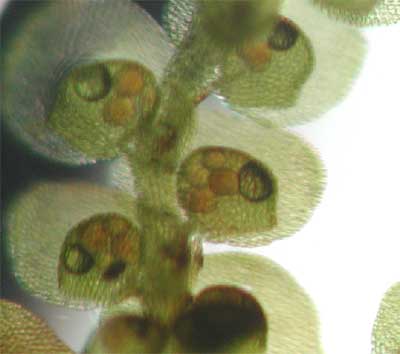
2002:
Gall size and gallmaker survival under different laboratory
temperature regimes: a comparison of two populations
Nicole. P. Kimball* and Mary N. Puterbaugh, Allegheny Institute
of Natural History, University of Pittsburgh-Bradford, Bradford,
PA, 16701. Contributed Paper (poster presentation) at 78th
Annual Meeting of the Pennsylvania Academy of Sciences, Pocono
Manor, PA, April 5-7, 2002.
Goldenrod galls and gallmakers collected in Pennsylvania
and New York (PANY) were compared to those collected in Missouri
(MO). Galls were randomly assigned to four laboratory treatments:
control, 5, -20, and -80 degree C treatment (N=70, MO; N=200,
PANY). Galls received these temperature regimes for two weeks.
Galls were opened, and larvae that failed to respond to prodding
were recorded as dying during the experiment. Galls lacking
gallmaker larvae were recorded as dying prior to the experiment
and are not included in survival estimates that follow. Among
MO gallmakers, 60, 40, 8 and 0% survived the experiment for
the treatments respectively. Among PANY gallmakers, 100, 89,
77 and 64% survived respectively. The percent surviving the
-80 treatment is surprising. The difference in survivorship
in MO versus PANY gallmakers is consistent with the hypothesis
that populations are locally adapted, though a more rigorous
investigation is needed to confirm this conclusion.
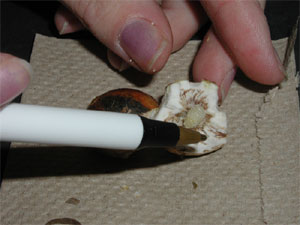
Patterns of rotifer abundance in lobules of an epiphytic
liverwort
John J. Skinner*, Jennifer M. Miller, and Mary N. Puterbaugh,
Allegheny Institute of Natural History, University of Pittsburgh-Bradford,
Bradford, PA, 16701. Contributed Paper (oral presentation)
at 78th Annual Meeting of the Pennsylvania Academy of Sciences,
Pocono Manor, PA, April 5-7, 2002.
We investigated the rotifers occupying lobules of the epiphytic
liverwort Frullania eboracensis. Samples of plants from a
field population were examined microscopically for sex and
rotifer abundance. Plant sex ratio was 44 female: 17 male:
20 unknown sex. Unknown plants were significantly smaller
than sex-expressing plants, and the ratio of rotifers to lobules
was significantly higher in the former than in the latter.
Unknown plants had a mean ratio (± 1 standard error)
of 0.83 (± 0.15) rotifers:lobule. Male and female plants
had a mean ratio of 0.38 (± 0.04) rotifers:lobule.
We also found that, within male and female plants, 68% of
the lobules at the edges of plants contain rotifers (±
1SE of 2.15%), whereas lobules in the interior of the plant
were less likely to contain rotifers (32 ± 4.40%).
These data suggest that rotifer density is higher in lobules
of young than in old plant tissue.
High rotifer abundance in liverwort plants lacking sexual
structures suggests that rotifers may prefer younger plant
tissue
John J. Skinner* and Mary N. Puterbaugh, Allegheny Institute
of Natural History, University of Pittsburgh-Bradford, Bradford,
PA, 16701.. Contributed Paper (oral presentation) at 12th
Annual Penn State Behrend-Sigma Xi Undergraduate Student Research
and Creative Accomplishment Conference, Erie, PA, April 20,
2002
We counted rotifers that live within lobular-shaped leaves
of an epiphytic liverwort (Frullania eboracensis). In the
summer of 2001, portions of marked plants growing near Olean,
NY were examined microscopically. Of the 81 plants, 44 were
female, 17 male, and 20 plants lacked sexual structures (sex
unknown). Plants lacking sexual structures were significantly
smaller than sex-expressing plants, and the ratio of rotifers
to lobules was significantly higher in former than in the
latter (mean ratio +/- 1 standard error of 0.83 +/-0.15 and
0.38 +/- 0.04 rotifers:lobules respectively). The fact that
the plants lacking sexual structures were smallest led us
to believe they were younger than sex-expressing plants and
that rotifers were preferentially living within younger plant
tissue. To test this, we returned to the field and sampled
the interior and exterior of 14 plants, knowing that within
a plant the exterior tissue is likely to be younger than the
interior tissue. The mean rotifer:lobule ratio in the younger
exterior parts of the plants was 0.67 (+/- 0.11) and significantly
higher than the ratio in the older interior parts of the plants
(0.22 +/- 0.05). We hypothesize that older plant tissue is
less hospitable for rotifers than younger plant tissue.
2001:
Preliminary investigation of the interaction between the
liverwort Frullania eborascensis and Bdelloid rotifers
Mary N. Puterbaugh*, Allegheny Institute of Natural History,
University of Pittsburgh-Bradford, Bradford, PA, 16701.. Contributed
Paper (poster presentation) at Annual Meeting of the Botanical
Society of America, Albuquerque, NM, August 12, 2001.
Bryophyte and invertebrate interactions abound, but they
are poorly understood. I examined the frequency of Bdelloid
rotifers within lobular-shaped leaves of an epiphytic liverwort
(Frullania eborascensis) in northwestern Pennsylvania. Liverworts
were randomly sampled from the bark of three neighboring streamside
trees from July through September, 2000. Between 13-68% of
the lobules on any given plant were occupied by rotifers (mean=30%;
N = 34 samples; 5054 lobules). Of occupied lobules, 71% contained
one rotifer, 20% two, and 9% three or more. This distribution
is significantly different from that expected at random (Chi-square
test using Poisson distribution for expected values, P<0.0001).
Although further analyses are needed to confirm this conclusion,
the excess of lobules with multiple rotifers supports the
hypothesis that rotifers reproduce within lobules and that
the plant-animal interaction could have fitness consequences
for the rotifer.
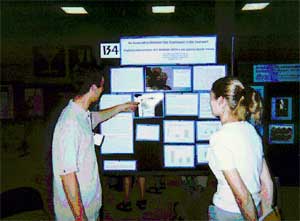
An association between sex-expression in the liverwort
Frullania eboracensis and Bdelloid rotifers occupying lobular
leaves
John J. Skinner* and Mary N. Puterbaugh, Allegheny Institute
of Natural History, University of Pittsburgh-Bradford, Bradford,
PA, 16701. Contributed Paper (poster presentation) at Annual
Meeting of the Botanical Society of America, Albuquerque,
NM, August 12, 2001.
During May, 2001, we investigated whether there was an association
between the abundance of rotifers occupying lobules of the
epiphytic liverwort Frullania eboracensis and sex expression
of the plants. At our field site in southwestern New York,
isolated patches of F. eboracensis (referred to as "plants"
and assumed to be unique genets) were marked on nine different
trees (N=81 plants). Portions of the plants were removed,
and examined microscopically in the laboratory. Presence of
sexual structures (antheridial branches and sporophytes) was
noted, and the numbers of rotifers and lobules were counted.
Plants were also measured for size. Plants for whom no sexual
structures were found were sampled at least twice more in
June to confirm lack of sex-expression. Of the 81 plants,
there were 44 females, 17 males, and 20 of unknown sex. Using
an analysis of variance followed by Tukey multiple comparison
tests, we found that unknown plants were significantly smaller
than sex-expressing plants and that the ratio of rotifers
to lobules was significantly higher in plants of unknown sex
than in either male or female plants. Plants of unknown sex
had a mean ratio (+/- 1 standard error) of 0.83 (+/-0.15)
rotifers:lobules. Male and female plants had a mean ratio
of 0.38 (+/- 0.04) rotifers:lobules. Within sexes, there was
no significant correlation between rotifer abundance and size
nor between rotifer abundance and the number of sexual structures
observed on the samples. Our results provide evidence that
this plant-animal interaction has ecological significance
to the taxa involved.
An association between sex-expression in the liverwort
Frullania eboracensis and Bdelloid rotifers occupying lobular
leaves
John J. Skinner* and Mary N. Puterbaugh, Allegheny Institute
of Natural History, University of Pittsburgh-Bradford, Bradford,
PA, 16701.. Contributed Paper (poster presentation) at 2nd
Annual Penn-York Undergraduate Research Conference, Buffalo
State College, Buffalo, NY, October 20, 2001.
Rotifers are small animals that are often found in moss and
liverwort plants. We investigated whether the abundance of
rotifers occupying lobules of the liverwort Frullania eboracensis
was associated with sex expression of the plants. Isolated
plants of F. eboracensis growing on the bark of large trees
were marked in southwestern New York (N=81 plants). Portions
of the plants were removed, and examined microscopically in
the laboratory. Of the 81 plants, there were 44 females, 17
males, and 20 of unknown sex. Using an analysis of variance
and Tukey comparisons, we found that unknown plants were smaller
than sex-expressing plants and that the ratio of rotifers
to lobules was significantly higher in plants of unknown sex
than in either male or female plants. Furthermore, the rotifer:lobule
ratio is higher at the edge of plants than in the center.
Our results provide evidence that this plant-animal interaction
has ecological significance to the taxa involved.
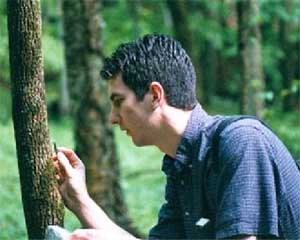
2000:
A Study of an Unusual Relationship Between a Plant and
Animal.
Mary N. Puterbaugh Mulcahy and Jennifer M. Miller*, Allegheny
Institute of Natural History, University of Pittsburgh-Bradford,
Bradford, PA 16701
Bryophyte and invertebrate interactions abound, but they
are poorly understood. We examined the frequency of Bdelloid
rotifers within lobular-shaped leaves of an epiphytic liverwort
(Frullania eborascensis) in northwestern Pennsylvania. We
randomly sampled liverworts from the bark of three neighboring
streamside trees from July through September, 2000. Between
13-68% of the lobules on any given plant contained at least
one rotifer (mean=28%; N = 24 samples; 3609 lobules). Of lobules
containing rotifers, 72% contained one rotifer, 17% two, and
11% three or more. This distribution is significantly different
from that expected at random (Poisson, X2=475, df=4, P<0.01).
Although further analyses are needed to confirm this conclusion,
the excess of lobules with multiple rotifers supports the
hypothesis that rotifers reproduce within lobules and that
the plant-animal interaction could have fitness consequences
for the rotifer.
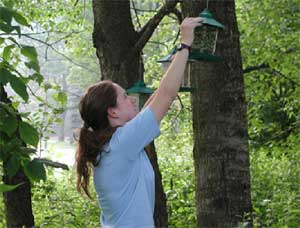
1999:
Fruit Color Preferences of Frugivorous Birds
Lisa VanGordon*, Eileen Burley, and Mary Puterbaugh, Allegheny
Institute of Natural History, University of Pittsburgh-Bradford,
Bradford, PA 16701
We tested whether frugivorous birds had a preference for
bicolored or monocolored fruit displays. To test the hypothesis
that bicolored fruit displays enhance fruit dispersal, we
made two bicolored displays (black fruit with red stems and
red fruit with black stems) and two monocolored fruit displays
(red fruit with red stems and black fruit with black stems.)
Fruits were made from flour, lard, and food coloring and were
hung in trees along Tunungwant Creek near the University of
Pittsburgh at Bradford campus in McKean County, PA, for two
weeks in November, 1999 (n=116 artificial fruits). Each tree
contained mixtures of all fruit display types. In contrast
to other studies, no preference by birds was detected for
fruit color, stem color or mono- or bicolored displays (chi-square
analysis, P>0.05).
Studies are underway to examine fruit removal rates among
the numerous trees, each consisting of one type of fruit display.
Dr. Mary Norris Puterbaugh
Mulcahy
AINH home page | UPB
| Return to Top
|

